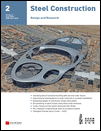
Steel Construction-Design and Research
Scope & Guideline
Empowering Engineers with Premier Steel Research
Introduction
Aims and Scopes
- Structural Performance and Analysis:
The journal consistently focuses on the structural performance of steel and composite materials, including topics like buckling, fatigue, and seismic behavior, using both experimental and numerical analysis. - Sustainability in Steel Construction:
A significant aim is to promote sustainable practices in steel construction, including the use of recycled materials, energy-efficient designs, and the development of eco-friendly construction methods. - Innovative Design Methods:
The journal highlights advancements in design methodologies, such as parametric design, machine learning applications, and data-driven approaches, which enhance efficiency and precision in steel construction. - Material Properties and Innovations:
Research on high-performance materials, including high-strength steels and innovative composite materials, is a core focus, aimed at improving the durability and efficiency of steel structures. - Code Compliance and Design Standards:
The journal contributes to the development and revision of design codes and standards, ensuring that research aligns with current regulations and best practices in the field.
Trending and Emerging
- Sustainable Construction Practices:
There is a growing emphasis on sustainability, with a significant increase in research related to the circular economy, reuse of materials, and environmentally friendly design practices that reduce the carbon footprint of steel construction. - Advanced Computational Techniques:
The rise of computational design methods, including parametric modeling and machine learning applications, is becoming more prevalent, showcasing the journal's commitment to integrating technology into structural design and analysis. - Seismic Resilience and Performance:
Recent publications have increasingly focused on the seismic performance of steel structures, reflecting a heightened awareness of the need for resilience in construction practices, especially in earthquake-prone areas. - Composite Steel Structures:
There is a noticeable trend towards exploring composite materials and hybrid structures, reflecting the industry’s interest in enhancing the performance and versatility of steel in construction. - Innovative Testing Methods and Experimental Studies:
An uptick in experimental research and innovative testing methods is evident, aimed at validating new design approaches and materials under various loading conditions.
Declining or Waning
- Traditional Steel Connection Methods:
Research on conventional steel connection methods has decreased, likely due to the introduction of more innovative and efficient connection technologies that address modern construction challenges. - Low-Tech Construction Techniques:
There has been a noticeable decline in papers focused on low-tech or traditional construction methods, as the industry increasingly adopts advanced materials and technologies to improve efficiency and sustainability. - Generalized Design Approaches:
The focus on generalized design methodologies has waned, as the journal has shifted towards more specific, case-based studies that provide detailed insights into particular applications or innovations in steel construction.
Similar Journals
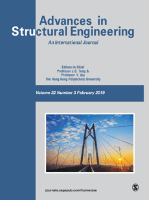
ADVANCES IN STRUCTURAL ENGINEERING
Exploring the Future of Structural Design and ConstructionADVANCES IN STRUCTURAL ENGINEERING, published by SAGE PUBLICATIONS INC, is a leading journal dedicated to the advancement of knowledge in the fields of Building and Construction, as well as Civil and Structural Engineering. With a solid impact factor and a commendable Scopus ranking (Rank #60 in Building and Construction, Rank #105 in Civil and Structural Engineering), this journal stands at the forefront of academic research, providing a platform for high-quality articles that contribute significantly to the discipline. Covering a range of topics from innovative construction techniques to sustainable engineering practices, the journal aims to foster collaborative dialogue among researchers, industry professionals, and students alike. As of 2023, it boasts impressive category quartiles, ranking Q1 in Building and Construction and Q2 in Civil and Structural Engineering. ADVANCES IN STRUCTURAL ENGINEERING is a vital resource for those looking to stay abreast of emerging trends and groundbreaking developments in structural engineering, promoting an environment of continuous learning and application of best practices. With a convergence of research from 1999 to 2024, the journal not only emphasizes theoretical frameworks but also bridges the gap between academia and practical application in engineering projects.
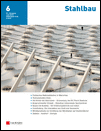
Stahlbau
Exploring Cutting-Edge Research in Building and Construction.Stahlbau is a prestigious journal published by ERNST & SOHN, focusing on the intersection of materials science, civil engineering, and mechanical engineering. With its roots dating back to 1968 and extensive coverage through 2024, this journal serves as a vital platform for the dissemination of innovative research and insights in the fields of Building and Construction, Civil and Structural Engineering, and Advances in Metals and Alloys. Despite its categorization in the Q3 quartile across several disciplines, it is recognized for its rigorous peer-reviewed articles and its commitment to advancing knowledge in structural engineering and materials' performance. The journal aims to foster a dynamic dialogue among researchers, industry professionals, and students, making it an essential resource for anyone looking to stay at the forefront of developments in construction and materials engineering. Access options reflect a commitment to intellectual exchange in academia, emphasizing the journal's role as a cornerstone for emerging research and best practices.
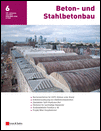
Beton- und Stahlbetonbau
Transforming Ideas into Concrete SolutionsBeton- und Stahlbetonbau is a renowned journal published by ERNST & SOHN, dedicated to advancing knowledge in the field of building and construction, particularly focusing on concrete and reinforced concrete engineering. Established in 1969, this peer-reviewed publication encompasses a broad range of topics, including innovative construction methods, structural analysis, and material performance, making it a crucial resource for researchers, scholars, and industry professionals alike. With an impact factor ranking it within the Q2 category in the Building and Construction field, this journal holds significant influence, evidenced by its Scopus rank of #112/223. Importantly, Beton- und Stahlbetonbau is committed to providing high-quality content that meets the academic rigor demanded by its audience, ensuring that readers remain at the forefront of technological advancements and research in concrete construction.

ENGINEERING JOURNAL-AMERICAN INSTITUTE OF STEEL CONSTRUCTION
Empowering Engineers with Pioneering Steel Solutions.ENGINEERING JOURNAL-AMERICAN INSTITUTE OF STEEL CONSTRUCTION, published by the American Institute of Steel Construction, stands as a vital resource for researchers, practitioners, and students in the fields of Building and Construction as well as Civil and Structural Engineering. With a history tracing back to its convergence in 1968 and an ongoing commitment to advancing engineering knowledge up to 2024, the journal is indexed under the ISSN 0013-8029. Despite its current open access status, the journal carries significant scholarly weight, reflected in its Q3 ranking in both relevant categories for 2023 and Scopus rankings indicating robust academic relevance within its sectors. The publication aims to disseminate innovative research, practical insights, and critical reviews that contribute to the enhancement of steel construction and infrastructure development. Situated in the heart of Chicago, the journal's dedicated focus on steel's pivotal role in engineering design and application forms an essential part of the conversation around modern building practices and sustainability challenges in the construction industry.

Teknik Dergi
Advancing the Frontiers of Civil EngineeringTeknik Dergi is a key academic journal published by the Turkish Chamber of Civil Engineers, focusing on the critical fields of Building and Construction as well as Civil and Structural Engineering. Established in Turkey, this journal serves as a vital platform for researchers, practitioners, and students to disseminate innovative findings and advancements within these disciplines. Although its coverage in databases like Scopus has been discontinued since 2022, Teknik Dergi remains a respected resource for its historical contributions, with a record of publication spanning from 1990 to 1998 and then from 2002 to 2022. The journal currently holds a Q4 categorization in both its primary fields, ranking within the 30th and 25th percentiles respectively. Authors and readers can access articles exploring practical applications and theoretical foundations, making it a valuable asset for those engaged in the rapidly evolving landscape of civil engineering. Open Access options are also available, allowing for broader dissemination and engagement with its published work.

Advanced Steel Construction
Advancing the Future of Steel EngineeringAdvanced Steel Construction is a prominent journal published by the Hong Kong Institute of Steel Construction, dedicated to the field of structural engineering and material sciences with a specific focus on steel construction techniques and advancements. Since its inception in 2005, the journal has established itself as a valuable resource for researchers, professionals, and students alike, offering insights into the latest developments and innovative practices within the realms of building construction, civil engineering, and materials mechanics. With its recognition as a Q2 journal across multiple engineering categories, including Building and Construction, Civil and Structural Engineering, Mechanical Engineering, and Mechanics of Materials, it ranks competitively in Scopus rankings, highlighting its significance in academic discourse. The journal is based in China, at the Hong Kong Polytechnic University, and provides an essential platform for sharing groundbreaking research and fostering collaboration within the engineering community.
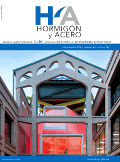
Hormigon y Acero
Elevating Standards in Concrete and Steel ApplicationsHormigon y Acero, an esteemed journal published by the ASOC ESPANOLA INGENIERIA ESTRUCTURAL-ACHE, serves as a vital resource in the fields of structural engineering and construction. With an ISSN of 0439-5689 and an E-ISSN of 2605-1729, this journal plays a critical role in disseminating innovative research and advancements from 2019 to 2024, particularly focusing on concrete and steel applications. Although it does not currently offer open access, its contributions remain invaluable to professionals and academics seeking to enhance their understanding and practices in engineering disciplines. Ranked within the 13th percentile in Building and Construction and the 9th percentile in Civil and Structural Engineering according to Scopus, Hormigon y Acero is recognized for its rigorous peer-reviewed content that addresses contemporary challenges and innovations within the industry. The journal is positioned in Madrid, Spain, and aims to foster collaboration and knowledge exchange among researchers, practitioners, and students dedicated to the advancement of structural engineering.

ACI STRUCTURAL JOURNAL
Unveiling the Future of Building with Scholarly ExcellenceThe ACI Structural Journal, published by the American Concrete Institute, serves as a premier platform for scholarly articles and research findings in the fields of building and construction and civil and structural engineering. With a commitment to advancing concrete technology and its applications, this journal has amassed an impressive reputation, holding a Q2 ranking in both Building and Construction and Civil and Structural Engineering categories as of 2023. The journal’s focus on innovative research and practical applications enables professionals, researchers, and students to stay at the forefront of industry developments. Although it does not offer open access, the content bears significant impact, ensuring that readers engage with high-quality research. As the journal converges its years of publication from 1987 to 2024, it continues to enrich the academic and professional discussions surrounding structural engineering and concrete science.

Journal of the International Association for Shell and Spatial Structures
Connecting Theory and Practice in Structural EngineeringJournal of the International Association for Shell and Spatial Structures (ISSN: 1028-365X, E-ISSN: 1996-9015) is a leading scholarly publication published by the International Association for Shell and Spatial Structures (IASS), based in Spain. The journal spans a remarkable history from 1969 to 2024, fostering groundbreaking research in the fields of shell and spatial structures while also contributing to broader disciplines such as arts and humanities, civil and structural engineering, and mechanical engineering. Notably, the journal has been recognized with a Q2 ranking in Arts and Humanities (Miscellaneous) and Q3 rankings in Building and Construction, Civil and Structural Engineering, and Mechanical Engineering for 2023. This positioning indicates a strong impact within its categories, enhancing the visibility of innovative research and practices. Although not labeled as open access, the journal remains a crucial resource for researchers, professionals, and students captivated by the complexities of structural design and engineering. By promoting interdisciplinary approaches and emerging technologies in structural systems, the journal serves as an indispensable platform for academic discourse and practical advancements in the field.
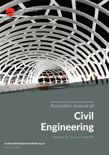
Australian Journal of Civil Engineering
Advancing the Future of Civil EngineeringThe Australian Journal of Civil Engineering, published by Taylor & Francis Ltd, stands as a pivotal platform within the field of civil and structural engineering. With an ISSN of 1448-8353 and an E-ISSN of 2204-2245, this journal consistently delivers high-quality research and innovative practices from both established and emerging scholars in the discipline. Recognized in the Q2 category for Civil and Structural Engineering in 2023, it holds a respectable position, ranking 146 out of 379 within its field according to Scopus, which places it in the 61st percentile. Converging valuable insights from 2011 through 2024, the journal encompasses a broad scope of topics, including sustainable infrastructure, innovative materials, and advanced construction techniques, thereby addressing contemporary challenges faced by engineering professionals. Though it is a traditional publication without open access options, the quality of the research featured ensures that it remains an essential resource for academics, practitioners, and students striving to enhance their knowledge and contribute to the dynamic field of civil engineering.